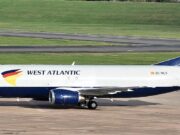
The following information provides an awareness of problems that might be avoided in the future. The information is based on final reports by official investigative authorities on aircraft accidents and incidents.
 Jets
Jets
Control Check Neglected
Gulfstream G-IV. Destroyed. Seven fatalities.
The U.S. National Transportation Safety Board (NTSB) determined that the flight crew’s “habitual noncompliance with checklists” was a contributing factor in the fatal overrun of the G-IV during takeoff from Hanscom Field in Bedford, Massachusetts, U.S., the night of May 31, 2014.
Disengagement of the “gust lock,” which mechanically immobilizes the flight controls to prevent them from being deflected and damaged by the wind when the airplane is parked, is included on checklists applicable both before and after starting the engines. However, neither pilot moved the large red gust lock T-handle on the center pedestal to the retracted position before taxiing the airplane onto the runway.
“Further, before initiating the takeoff, the pilots neglected to perform a flight control check that would have alerted them of the locked flight controls,” said the NTSB report. “A review of data from the airplane’s quick access recorder revealed that the pilots had neglected to perform complete flight control checks before 98 percent of their previous 175 takeoffs in the airplane, indicating that this oversight was habitual and not an anomaly.”
Both pilots were qualified as pilot-in-command (PIC) in the G-IV, and they had flown together regularly. The pilot designated as PIC for this flight had more than 11,250 flight hours, including 1,400 hours in type. The second-in-command (SIC) had more than 18,500 flight hours, with over 2,800 hours in G-IVs.
Early in the afternoon, the pilots and a flight attendant had repositioned the airplane from its base in Wilmington, Delaware, to pick up four passengers in Atlantic City, New Jersey, and fly them to Bedford. About 2130 local time, the passengers re-boarded the airplane for the flight back to Atlantic City.
As the pilots initiated the takeoff from Hanscom’s 7,011-ft (2,137-m) Runway 11 about nine minutes later, the PIC felt a restriction as he moved the throttles forward. The restriction was caused by a throttle-interlock system designed to prevent takeoff with the gust lock engaged. Rather than rejecting the takeoff after encountering the throttle restriction, the PIC engaged the autothrottle system, which provided only a slight increase in power.
The pilot apparently realized that the gust lock was engaged when he attempted to rotate the airplane for takeoff. The PIC told the SIC “lock is on” and then attempted to unlock the flight controls by activating the flight power shutoff valve, which removes hydraulic pressure from the flight-control actuators and causes the elevator, rudder and ailerons to revert to manual operation.
About 11 seconds after the unsuccessful attempt at rotation, the pilots initiated a rejected takeoff by applying manual braking and retarding the throttles. Groundspeed was 162 kt, and there were 1,373 ft (418 m) of runway remaining. The PIC said “I can’t stop it” shortly before the airplane ran off the end of the runway and the paved overrun area at 105 kt, traveled through the airport perimeter fence and struck a ravine.
“The impact forces from the accident were survivable, but the cabin and cockpit environment quickly deteriorated due to [a] postcrash fire, which erupted immediately, spread rapidly and prevented the occupants from escaping,” the report said.
The NTSB concluded that the probable cause of the accident was “the flight crewmembers’ failure to perform the flight control check before takeoff, their attempt to take off with the gust lock system engaged and their delayed execution of a rejected takeoff after they became aware that the controls were locked.”
The board also said that Gulfstream’s “failure to ensure that the G-IV gust lock/throttle lever interlock system would prevent an attempted takeoff with the gust lock installed” and the U.S. Federal Aviation Administration’s “failure to detect this inadequacy during the G-IV’s certification” contributed to the accident (ASW, 11/15).
Ice Impedes Elevator Control
Boeing 737-800. No damage. No injuries.
Before departing from Helsinki, Finland, with 173 passengers and six crewmembers the morning of Dec. 26, 2012, the 737 was deiced to remove about 25 cm (10 in) of snow that had accumulated on the airframe.
The subsequent flight to Kittilä, Finland, was uneventful until the aircraft intercepted the instrument landing system glideslope. Elevator trim activated for 12 seconds, pitching the aircraft nose-up, and the autothrottles commanded full thrust.
“Both pilots eventually pushed the elevator control column with full force, but the aircraft’s nose continued to pitch up to an angle of 38.5 degrees before slowly decreasing,” said the report issued in March 2015 by the Accident Investigation Board of Norway (AIBN).
Airspeed decreased to 118 kt, and angle-of-attack reached 25 degrees. “The aircraft was thus close to stalling,” the report said. “The aircraft’s autopilot was disengaged just after the aircraft’s nose angle was at its highest. Control over the aircraft was slowly regained,” and the flight crew subsequently landed the 737 without further incident.
Investigators found that deicing fluid had entered the aircraft’s tail cone and had frozen on three of the four input cranks for the elevator power control units, causing the power control units (PCUs) to function abnormally.
“The investigation has documented that, even after the introduction of new de-icing procedures from Boeing, considerable amounts of fluid and humidity are entering the tail cone compartment during de-icing,” the report said. “AIBN believes there is a need for measures that prevent ice formation on the input cranks and thus reduce the risk of blocking normal elevator function on the Boeing 737 series.”
Rammed by a Service Truck
Boeing 737-800. Substantial damage. One serious injury.
A service truck was being driven in reverse toward the toilet-service panel on the lower left side of the fuselage while passengers were boarding the aircraft for a flight from London (England) Gatwick Airport the morning of Dec. 23, 2014.
The truck driver later told investigators that he accidentally pressed the accelerator rather than the brake, said the report by the U.K. Air Accidents Investigation Branch (AAIB). The truck struck the aircraft, tearing the fuselage, and crushed a ground crewmember against a baggage conveyor.
“The man who was injured was [guiding] the driver whilst he reversed, as required by company procedures,” the report said. “[He] appeared to be standing directly behind the vehicle he was directing rather than to one side, which is better practice.”
APU Door Unlatched
Gulfstream G-200. Substantial damage. No injuries.
The airplane was climbing through 16,000 ft near Savannah, Georgia, U.S., during a post-maintenance flight check the afternoon of Jan. 14, 2014, when the flight crew heard a thud and felt the airframe shudder momentarily.
“The flight crew observed no other anomalies and did not experience any abnormal handling characteristics with the airplane during the remainder of the flight,” said the NTSB report.
After landing the G-200 in Savannah, the pilots saw that the auxiliary power unit (APU) service door was open and bent, and that the lower portion of the rudder was substantially damaged. “The door’s lower latches were partially engaged, and a detailed examination revealed no anomalies with the latch assembly,” the report said.
The NTSB determined that the probable cause of the accident was “maintenance personnel’s failure to properly secure the [APU] service door before returning the airplane to service.”
 Turboprops
Turboprops
Severe Icing Triggers Stall
Saab 340B. No damage. No injuries.
The flight crew activated the anti-ice and deice systems when the aircraft encountered instrument meteorological conditions (IMC) while climbing through 6,500 ft during a flight with 25 passengers from Aberdeen to Sumburgh, Scotland, the morning of Oct. 3, 2014.
Rate of climb decreased as the 340 climbed through 11,000 ft. “A small amount of ice had formed around the windscreen wipers, but the commander initially assessed that the reduced rate of climb was due to downdraughts caused by mountain wave effect,” said the AAIB report.
The commander, who was flying the aircraft on autopilot, attempted to increase vertical speed by reducing the indicated airspeed from 160 kt to 145 kt, the minimum speed for flight in icing conditions.
“The commander realised the aircraft was being affected by ice, as well as by mountain wave effect, but was confident that it was close to the cloud tops and would climb above the icing level,” the report said.
Rate of climb varied from 800 fpm to a slightly negative value. “Approximately 3/4 inch [1.9 cm] of ice could be seen on the windscreen wipers, while the de-icing boots on the wing appeared to clear any ice that formed on them,” the report said.
Investigators later determined that the aircraft was in moderate icing conditions and subsequently entered severe icing conditions after climbing through 12,500 ft and leveling at the assigned altitude of 13,000 ft.
The aircraft accelerated to 164 kt, rather than the expected 180 kt. The commander attempted to increase the cruise airspeed by climbing 100 ft and then descending back to 13,000 ft. “The commander thought that the angle of attack (AOA) and drag would reduce during descent and the aircraft would accelerate,” the report said. Instead, indicated airspeed decreased to 150 kt.
The crew then requested clearance from air traffic control (ATC) to descend to 11,000 ft. “After ATC had approved the descent, the commander commented that the ice conditions were more than moderate [as had been forecast] and that the airframe was accumulating a lot of ice,” the report said.
The autopilot was still engaged, and the commander selected a vertical speed of 1,000 fpm. However, the aircraft’s pitch attitude remained about 5 degrees nose-up, and the captain increased the selected vertical speed to 2,500 fpm.
“The airframe then started to vibrate, and the commander said, ‘Feel that? That’s a stall, I think. Icing stall,’” the report said. However, stall recovery was delayed for 10 seconds, when the stall-warning horn sounded, the stick shaker activated and the autopilot disengaged.
The commander hand flew the aircraft to 11,000 ft. “He later reported that a little more force than usual had been required to lower the nose of the aircraft, but it then responded normally as the speed increased to greater than 190 kt,” the report said.
The crew continued the flight to Sumburgh at 11,000 ft and landed the aircraft without further incident.
Mountain Obscured by Cloud
De Havilland DHC-6-300. Destroyed. Three fatalities.
The flight crew made two hourly radio reports after departing on a visual flight rules (VFR) positioning flight from South Pole Station, Antarctica, to a research station at Terra Nova Bay, about 885 nm (1,639 km) north the morning of Jan. 23, 2013. But a third hourly report was not received, and an emergency locator transmitter signal was detected near Mount Elizabeth, about halfway along the route.
Extreme weather conditions hampered search-and-rescue operations. The wreckage of the Twin Otter was found two days later at 13,000 ft on a steep slope, said the report by the Transportation Safety Board of Canada.
Analyses of on-board tracking data and weather conditions in the vicinity of Mount Elizabeth indicated that the Twin Otter crew had encountered widespread IMC with high winds and turbulence, and had prematurely turned left before traversing a pass leading to lower terrain on the Ross Shelf.
The data indicated that the aircraft was being flown at 12,500 ft about 45 seconds before impact when the pilots responded to a terrain awareness and warning system (TAWS) advisory. However, “aircraft climb performance was not sufficient to avoid the terrain,” the report said.
Rudder Trim Mispositioned
Beech King Air C90. Substantial damage. No injuries.
The pilot told investigators that the King Air veered sharply right while departing from Runway 05 at Oneida, Tennessee, U.S., the afternoon of Sept. 25, 2014. He assumed that the right engine had failed and turned back to land in the opposite direction, on Runway 23.
“Seconds after the airplane touched down, it began to veer to the left,” the NTSB report said. “The pilot applied power to the left engine and right rudder, but the airplane departed the left side of the runway.”
The airplane was substantially damaged when the right main landing gear and nose landing gear collapsed, but the pilot escaped injury.
“The pilot reported that he had failed to configure the rudder trim prior to takeoff and that there were no pre-impact mechanical malfunctions or anomalies that would have precluded normal operation,” the report said.
 Piston Airplanes
Piston Airplanes
Control Lost in Night IMC
Piper Chieftain. Destroyed. One fatality.
The pilot and dispatch personnel agreed that the first leg of the cargo flight, from Holbrook to Payson, Arizona, U.S., would be conducted under VFR the evening of Dec. 18, 2012. However, meteorological conditions precluded a visual approach to Payson, and the Chieftain was not equipped to conduct the global positioning system approach to the airport, the NTSB report said.
ATC radar data showed that the Chieftain made a series of turns, descents and climbs, indicating that “the pilot made a dedicated effort to access the airport while concurrently remaining clear of the clouds and terrain,” the report said.
The pilot then contacted ATC and received clearance to Phoenix, the final destination for the cargo flight, and to descend from 13,500 ft to 10,000 ft. Investigators determined that the pilot likely encountered night IMC with mountain wave activity and possibly severe icing conditions at 10,000 ft.
He subsequently requested a lower altitude because of strong drafts, but the controller was unable to comply due to the 9,700-ft minimum vectoring altitude in the area. “About one minute later, radar contact was lost,” the report said. “Shortly thereafter, the airplane impacted terrain in a steep nose-down attitude in a near-vertical trajectory.”
Fuel Starvation
Piper Aerostar 601P. Substantial damage. One fatality.
A mechanic who conducted an engine run-up at Philadelphia, Mississippi, U.S., the morning of Jan. 16, 2012, told investigators that the Aerostar’s wing tanks held only a few gallons of fuel and that the fuselage tank was nearly full when he shut down the engines.
The pilot apparently did not position the fuel selectors properly before attempting the subsequent takeoff, the NTSB report said. The “Starting Engines” checklist requires that both fuel selectors be positioned to “CROSSFEED” momentarily to check for movement of the crossfeed valve and then back to “ON.”
Investigators determined that, although the right fuel selector was “ON,” the pilot likely did not return the left selector to the “ON” position and did not subsequently re-check the selectors as required by the “Before Takeoff” checklist.
“Thus, the left engine was being fed only from the right fuel tank, which had very little fuel,” the report said. “There was likely enough fuel in the right tank and lines for the pilot to taxi and take off before the left engine failed.”
A witness saw the Aerostar roll left after lift-off and strike terrain in an inverted attitude. “A post-crash fire consumed most of the cockpit, cabin, both wings and aft fuselage,” said the report, which nevertheless classified the damage as “substantial.”
The NTSB concluded that the probable cause of the accident was “the pilot’s failure to maintain directional control during takeoff following loss of power to the left engine due to fuel starvation.”
 Helicopters
Helicopters
Unseen Obstacle
Airbus EC135-P. Destroyed. Two fatalities, one serious injury.
The emergency medical services (EMS) helicopter departed from its base in Lorenskog, Norway, to fly to the site of a motor vehicle accident in Sollihogda the morning of Jan. 14, 2014. There were clouds and light snow at the site, but they did not affect the mission, said the AIBN report.
While approaching the site, which was in mountainous terrain between two highway tunnels, the helicopter struck a power line 82 ft above the ground. The main rotor was extensively damaged, and the helicopter entered a vertical descent. The pilot and the flight physician were killed, and the EMS crewmember was seriously injured when the EC135 struck the ground.
“The power line was not physically marked and was unusually difficult to detect from the air,” the report said. Although the power line would have been depicted on the on-board moving map display, EMS personnel had experienced difficulty with the obstacle database and company procedures did not require its use.
Noting that obstacles pose a substantial risk during low-altitude operations, especially at unfamiliar landing sites, the AIBN recommended that “predefined landing sites should be used as much as possible, the existing obstacle database should be improved and utilised more effectively, and the work to identify and control the risk of such operations should be strengthened.”
Undetected Descent
Aerospatiale AS350-B2. Destroyed. Two serious injuries.
The AS350 was one of two helicopters that were returning to Davis Base, Antarctica, the evening of Dec. 1, 2013, after taking a scientist and two field training officers to a penguin rookery in Cape Darnley. The return flight, with the scientist and one training officer aboard the accident helicopter and one training officer aboard the other helicopter, would require refueling at fuel caches pre-positioned on the Amery ice shelf and at Sansom Island.
During the flight to Sansom Island, the pilots noticed that weather conditions were deteriorating rapidly and decided to return to the cache site on the Amery ice shelf and wait for conditions to improve, said the report by the Australian Transport Safety Bureau.
While turning back, the pilot likely experienced spatial disorientation and did not realize that the helicopter was descending, the report said. “Factors contributing to the disorientation included a loss of visual cues as a result of the change in weather conditions and a breakdown of the pilot’s scan of his flight instruments.”
The two passengers and the pilot were seriously injured when the AS350 struck the ice shelf. The other helicopter landed, and the pilot flew the injured people the next morning to Sansom Island, where they were taken by an airplane to a hospital in Tasmania.


